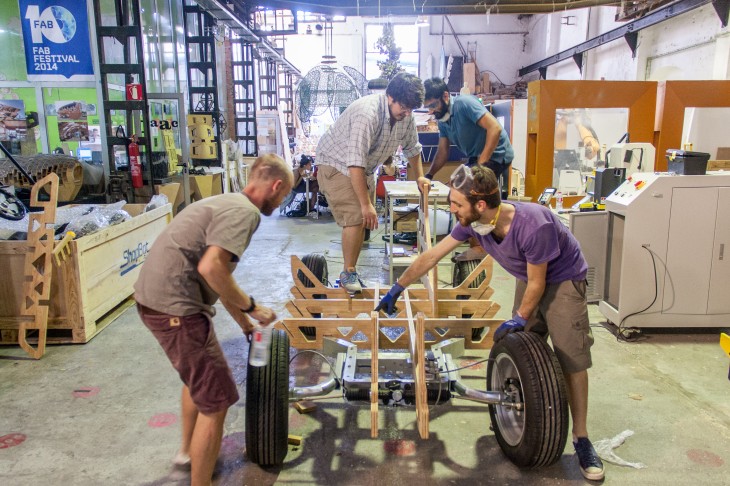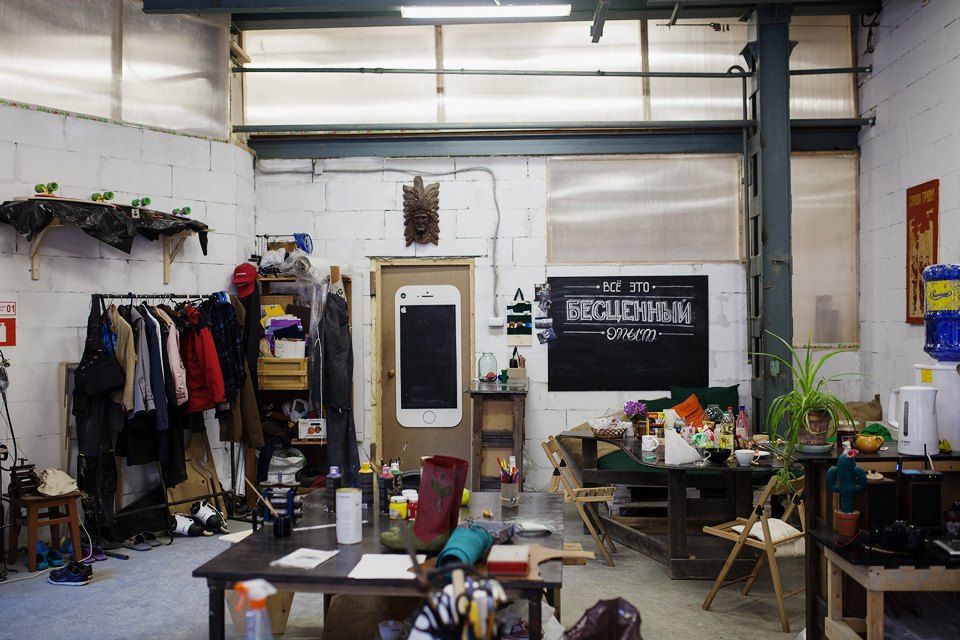Over the past decade, many open creative workshops and creative spaces have appeared in the world, offering access to tools, machines and high-tech equipment. Such places are called coworking workshops, hackspaces, makerpaces, FabLabs. In fact, they are all united by one concept - these are public spaces that provide tools and equipment for those who want to do something with their own hands.

Cooperation, collaboration and co-creation are the three principles that underlie the creative space. This model of joint consumption has been spreading in the world since the mid-2000s. Her idea is that it is more convenient to pay for temporary access to a product than to own this product.
Despite the general concept, creative spaces have certain differences, which are reflected in their names. Moreover, the definition of the type of creative space is not based on the set of equipment and tools, or type of activity, but on the principles of community organization, knowledge sharing and learning. Each creative space is unique and reflects the needs and desires of its community.
Hackspace
From Wikipedia: hackspace (English hackerspace) - a place where people gather with similar interests, scientific, technological, in digital or electronic art, communication and joint work.
Hacking, as a creative approach, consisting in the transformation of simple units into complex ones, was born in the 1960s at the Massachusetts Institute of Technology (MIT). Then, hacking was understood to mean finding “an elegant way”, “hack” (hack) to solve a scientific and technological problem that would be the most effective and optimal. In the MIT environment, it was believed that only a specialist of the highest level could develop such a solution. Such specialists were called "hackers."
Another feature of hacking was the concept of free dissemination of information. With the advent of the Internet in the 1980s, a culture of open source software was formed, which was picked up by a group of hackers. This meaning of “hacker” as a hacker prevailed until hackspocks appeared - public spaces that revived the primary meaning of hacking as a creative activity. An approach to the development and use of technologies that were supposed to be free for all was formed in hackspaces. Here they began to be engaged not only in open source software, but also in the creation of physical objects, which are the link between programs and the real world.

The main feature of hackspace in comparison with other creative spaces is self-organization and autonomous functioning at the expense of its participants. Anyone can come there and look at the available equipment, but in order to conduct their activities there, it is necessary to make monthly contributions to maintain the site. In the hackspace, the hierarchy and structure are denied, there are no managers, no specialized assigned functions, no closed developments. However, the absence of a governing body, independence and equality of participants of a hackspace can lead to confusion and confusion. As a result, the management of a hackspace focuses on one person or a small group of participants. Hackspace activities are mainly related to electronics and programming.
Makerspace
The term “makerspace” appeared in 2005 with the publication of the magazine “Make”, which combined the “do it yourself” movement with the hacker subculture. In 2010, the founder of the magazine “Make”, Dale Dogretri, registered the web resource makerspace.com, after which this term was used everywhere to refer to public spaces associated with the design and creation of various things “from scratch”. It promoted the free use of technology, collaboration, the exchange of experience between participants, and craft training.

In the future, the makers began to abandon the hacker ideology, the craftsmen did not want to associate themselves with hacking as hacking information systems. In the maker space, the community was shaped around the use of technology, and not around ideological issues, as it was in hackspaces. The functioning of the makers began to be carried out on a commercial basis in the form of a business for its organizers.
Makerspaces are public workshops in which you can do any work: from tailoring to metal welding. Different types of creative activities here do not look shattered, but are perceived as a single creative process. Anyone can come to the makerspaces: both amateurs and professionals. Here you can find accomplices for the project, acquire new knowledge and skills, gain experience in working in a team.
Fablab
FabLabs (from the English. Fabrication laboratory) is a network of production laboratories that was founded by Neil Gershenfeld at MIT in 2005. Neil created FabLab, inspired by MIT's “How to do (almost) anything” courses. The main idea of Neil Gershenfeld is that machines that make more complex machines will replace the machines that make things. In this case, materials containing information will be used. Based on this information, the materials will form objects independently. Thus, the programmable material itself becomes a machine. Neil states that the next goal of the project is to create a laboratory that creates laboratories.

So, FabLab is a prototyping laboratory whose main equipment is a CNC machine, a 3D printer, a 3D scanner, a laser cutter, a device for the manufacture of printed circuit boards. The equipment is chosen so that the novice designer can realize any of his ideas. The name “FabLab” is a trademark, therefore its application to any creative workshop with similar format is inappropriate. FabLabs have special requirements for the organization of space in the laboratory, for a set of necessary tools, software and training courses. It can be said that this is a kind of franchise.
A feature of the FabLab network is that all laboratories share their knowledge and developments. Laboratories have a common information base. Participants can exchange information and consult with specialists through a video conferencing system. FabLabs help to effectively promote technical projects of their participants in the market. FabLabs are open to everyone for a small fee and are most often managed by local non-profit organizations.
CMiT
The Center for Youth Innovative Creativity (TsMiT) is a platform for attracting young people to scientific and technical creativity, laying the foundations of scientific and technical literacy and motivation to receive engineering and technical education. TsMiT is a Russian project, based on the experience of the FabLab laboratories, but every TsMiT chooses its equipment independently, depending on the tasks.
The main areas of activity are prototyping, modeling, 3D printing, work on CNC machines and laser cutters.

In addition to working independently with the equipment, various training courses are held here. Depending on the TSiMT, work on the site for anyone who wants can be either paid or free.
Since 2012, the creation of the TsMiT in Russia has been carried out under the Program of State Support for Small and Medium-Sized Businesses. Due to the specifics of the legislation, entrepreneurs have also become users of the TSiM, in addition to young people and children. This led to the fact that many of the TsiMiT in Russia now represent a small production sites that use the equipment obtained under the state program for commercial purposes.
Coworking workshop
The co-working workshop is essentially a more specialized specialty spacespace. Such workshops are equipped with tools and equipment for practicing one or two branches of crafts. In most cases, these are carpentry workshops that provide access to woodworking machines on loan. Payment of rent consists in the acquisition of a subscription, giving the opportunity to work in the workshop for a fixed amount of time. The most common subscriptions are per hour, per day and per month. Co-working workshops, operate exclusively on commercial bases and do not necessarily adhere to the ideology of the Makers.

In the workshop of coworking everyone can work, and even children under the supervision of adults. Before embarking on an activity, it is necessary to undergo safety instructions and confirm the skills of using this or that tool or machine. If the visitor does not have the necessary skills, but wants to master the craft or learn how to work on one of the machines, then he can take training courses. In workshops coworking often hold workshops on the manufacture of various products with their own hands.
Popularization of creativity in Russia
In our country, a “do-it-yourself” movement began in the USSR in the 50s of the last century under the influence of information technology, computers and electronics. Despite the wide spread of the IT-industry and software products - “software”, the development of technologies is impossible without hardware - “hardware”. That “iron” and engaged in public workshops. People come there to change the scope of activities, switch, return to manual labor.

The most common format of creative space in Russia is coworking workshop. Creative production sites based on the site of former factories or plants are gaining popularity. They include various creative spaces and workshops. When this works, the principle of synergy works: the effect of combining and interacting significantly exceeds the sum of the effects of each component separately. In general, there is a steady growth of interest in creativity and crafts. It is possible that the popularization of the culture “do it yourself” will be able to bring culture and technology in our country to a new level.
Literature:
“Macking as a socio-economic phenomenon” O. Bychkova, N. Evstigneeva, A. Simonova, A. Chernysh, 2015